Benefits of Continuous Integration For Customers: Cleveroad Experience
Updated 20 Mar 2023
9 Min
4113 Views
A customer who is looking for a company to work with wants to be sure that his vendor is better than the others on the market. Such a customer wants the fastest, the most reliable and the most creative people who are able to deliver quality products on time. He wants us. Cleveroad is a successful company because we keep up with the pace and requirements of the modern world and our demanding clients. And it has nothing to do with luck, it's the result of hard work and approaches which makes us better for our customers. One of such approaches is continuous integration. This article is about all the reasons why continuous integration is so important for all product owners and startups.
What is continuous integration?
Software development process differs from any other manufactures and you have to understand that bugs are an essential part here. Still, continuous integration best practices create a new philosophy to deal with them. Before CI, each developer on a project created his part, tested it and only then committed. Despite a fact that each piece of code worked seamlessly, the project itself had lots of bugs after building and was more like a puzzle which consists of many separate parts. The old system suggested developers create software following these four stages:
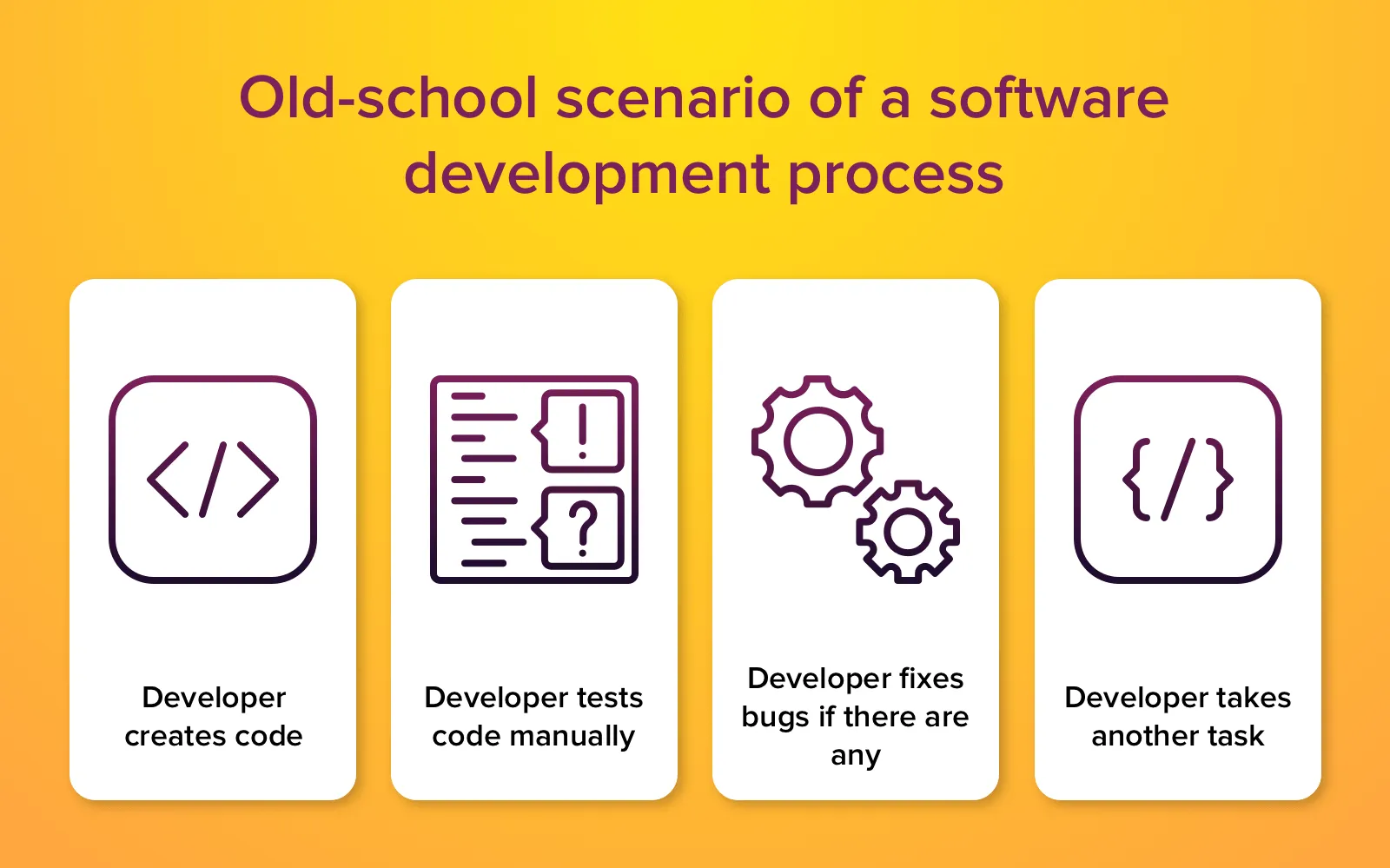
How developers worked before CI
At first, developers created code, then they tested it manually if there were any bugs, they fixed them and took another task immediately.
Such a common way of mobile and web development has a huge drawback. The manual testing performed by a developer can only check the functionality of a piece of code in a particular environment and specific moment of time. But what will happen if another developer changes some other components in the system? What if we change the environment and add new components? Will a developer continue checking all the code manually after each integration? How long will it take? Is it an effective way to create software? No!
Read our programming outsourcing guide. We'll talk about how to outsource the programming properly and why it's beneficial for businesses
The old approach is not only imperfect, it had no chances to become successful. While the best continuous integration tools change the rules of the game. Applying CI, developers don't need to rely on others. They can be sure that the code will work smoothly even if all the variables change. How does continuous integration work? The approach depends on three main continuous integration principles:
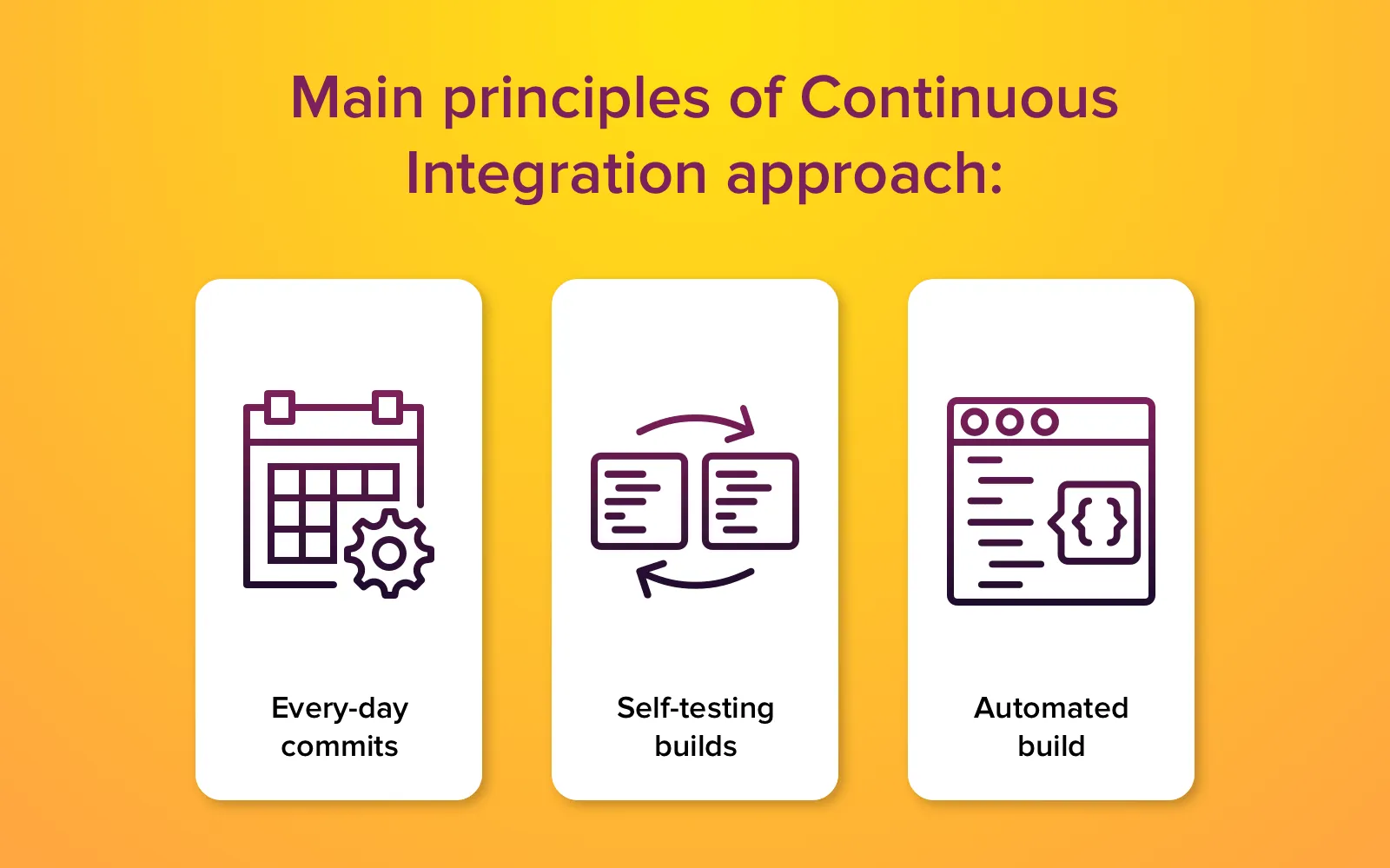
Continuous integration principles
Every-day commits
The main drawback of the common approach is that a developer created large pieces of code and only then committed it. One of the main principles of continuous integration is frequent integrations. This approach allows developers to detect errors and fix them as soon as possible. The continuous integration software, (in our case it's Jenkins) adds each commit and tests the whole project changing the variables all the time. In such a way, you get a project (even if it isn't finished yet) which works without bugs. And developers can easily add new components without fear that something would go wrong.
We do our best to provide you with fantastic products that's why we keep up with the world's quality standards at Cleveroad. Press here, if you want to know how we do that!
Self-testing builds
One of the main continuous integration concepts is self-testing builds. Such builds test themselves automatically and it excludes the need for manual testing. These builds are scalable and repeatable and work much better than people. It saves a lot of hours which you don't have to pay for!
Automated build
An automated build is a huge advantage of the continuous integration process. No need to check all files, no need to worry about file sync. It doesn't actually matter what kind of project you have, very simple or vice versa sophisticated. The program will do it without any mistakes.
Such a new approach to the software development brings tonnes of positive changes to you. Here are the brightest business benefits of continuous integration process:
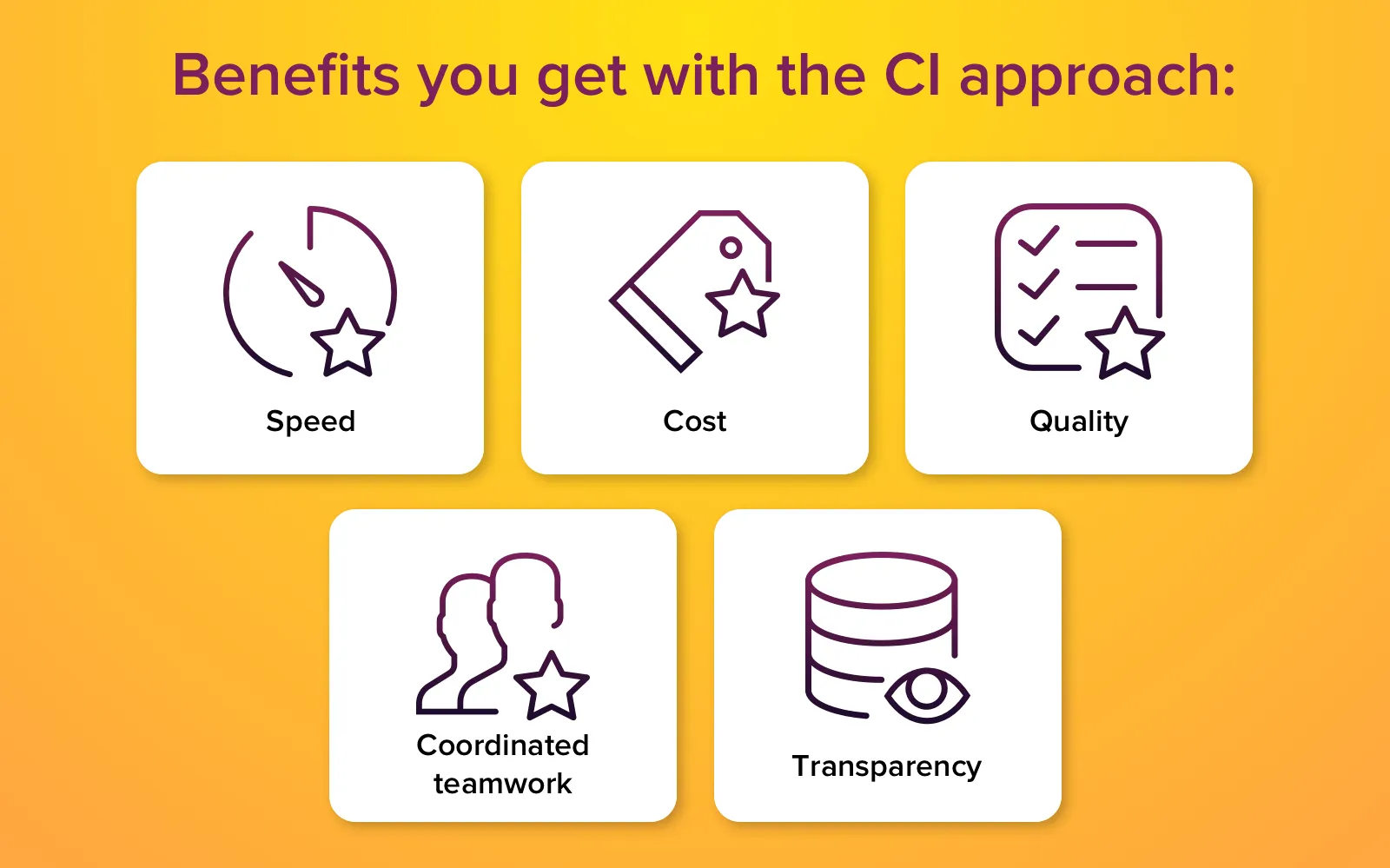
Advantages of continuous integration
Speed
All processes which can be automated are automated. The system runs tests all the time and detects bugs fast. In a few seconds, developers get a report and start fixing immediately. After the project has been finished we perform regression testing which takes minimum time.
Cost
If the protect takes less time it also costs less. When you are looking for a company to hire ask them how they test software. If they rely more on manual testing and don't use automation testing (and your project is really big) then it would take them ages to test your product, find and fix all bugs while you'll still be paying for this.
Quality
With the automation testing, a created piece of software has much fewer bugs at the end of the development. Besides, the continuous integration principles teach to engage all team members in a process. In such a manner, if a problem occurs, all participants are looking for a solution on their level.
Watch our simple video with a detailed explanation of how we interact with our customers and how we perform the development process at Cleveroad in plain English! All the insights and our secret methods are here!
Development Process at Cleveroad: How We Create Software
Coordinated teamwork
Many customers complain about their team doesn't work well, when they hired a group of freelancers or some young, inexperienced development companies. Such customers truly believe that they can get coordinated teamwork from people who barely know each other. It not only the fact of acquaintance that matters but also the rules and procedures a team follows during their work. CI distributes duties and responsibilities and gets rid of such a notion as silos - when each developer care about only his or her part of work but not the project in whole.
Transparency
Even after a few weeks of work, we can show you what we've done, after a sprint we show a demo of the implemented functionality, so you know what you pay for. Such an approach helps build honest and open relationships.
Jenkins and continuous integration
As we've already mentioned, we use Jenkins continuous integration tool here at Cleveroad. We've used it for more than two years and can say that it is the best tool for our company's needs. To understand why we like it so much and what assets it has, at first, It's better to explain to you what it is and how it works briefly.
Jenkins is a continuous integration server. It's an open-source platform for continuous integration and deployment automation. In simple terms, Jenkins pulls repository with code, compiles the final version in the repository and commits this version into hosting. The platform is compatible with various version control tools. In our case it's Git. Jenkins has lots of testing capabilities, which we use all the time to deliver you a bug-free product. Why did we choose Jenkins? Because it has a range of advantages which make it stand out from the rest of tools. For instance:
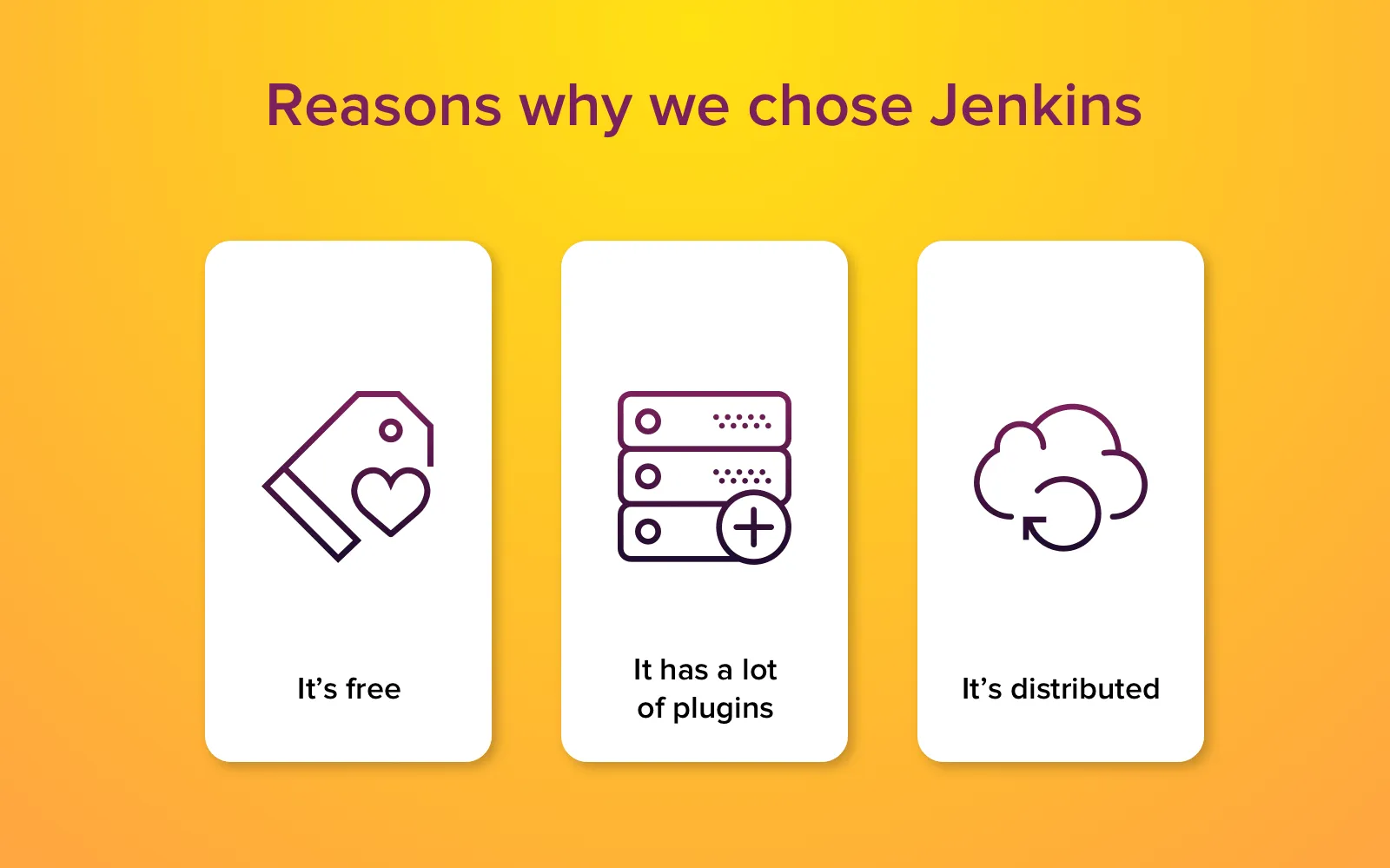
Benefits of CI tool Jenkins
It's free
Yes, that's right, it's use is unlimited, which means you pay nothing for it. Which makes the cost of your project less.
It has various plugins
Jenkins has plenty of plugins which extend it's capabilities significantly. For instance, Dashboard View is needed to create dashboards with graphics and additional result tables. Email Extension Plugin allows us to send emails in a more convenient way. Jenkins Sonarqube Plugin is needed for statistic analysis of code.
It's distributed
The program is able to distribute work across various machines using distributed builds with remote agents. As well as that, it drives builds, tests and deployment across different platforms very fast.
Want to create an app but don't know it's cost? Press here and find out how much you should pay for your future project with our FREE app cost calculator!
How to implement continuous integration
When we started to adopt continuous integration strategy, we needed to make some correction in our workflow. Below, you'll find the list of the taken measures, which can also become a guide for other companies that are only starting to implement continuous integration:
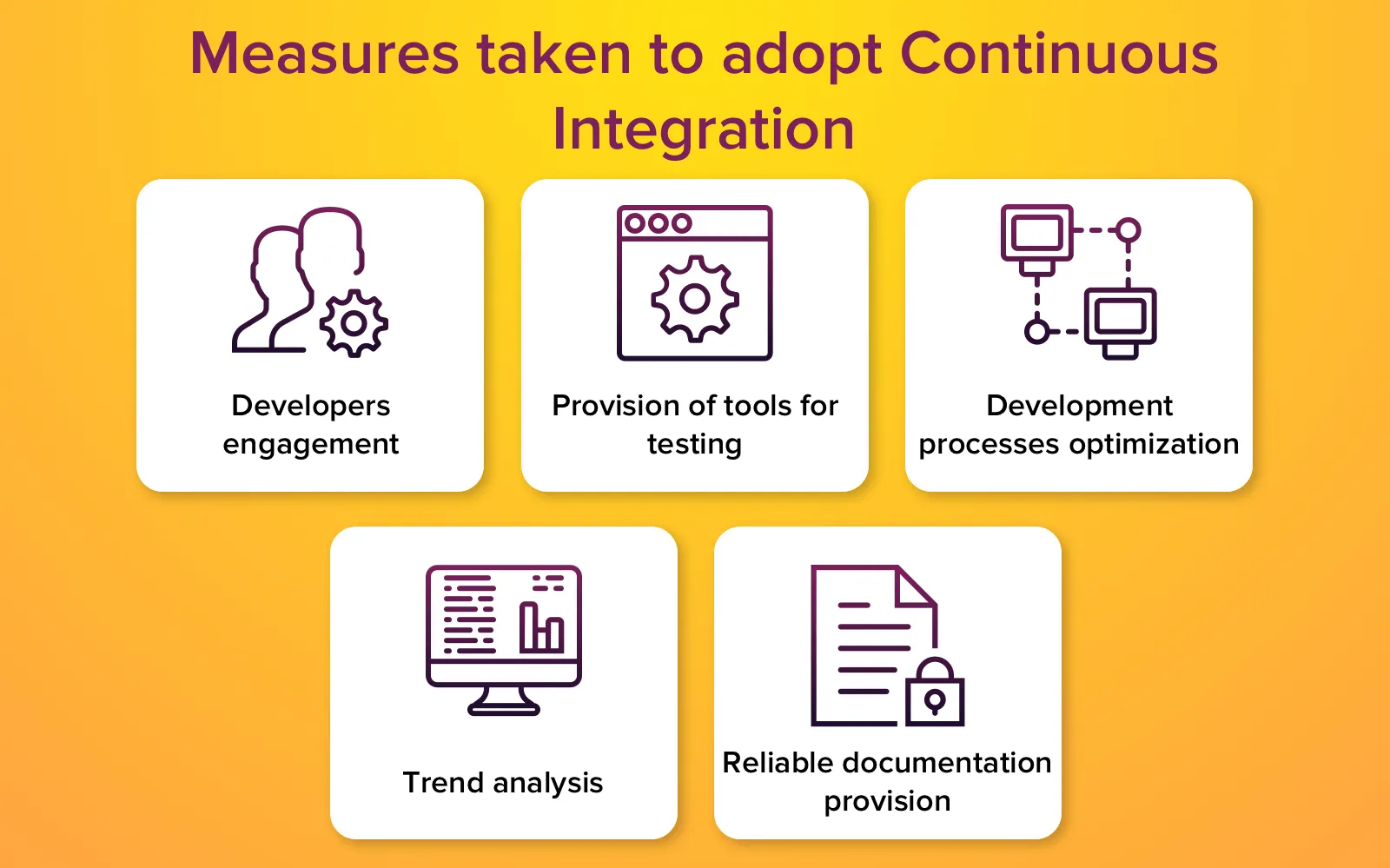
Continuous integration methodology adoption
- Developers engagement to better understand process flow and all dependencies for accurate testing. By doing this we've improved the quality rapidly.
- Provision of tools for testing at any stage of development and deployment. The more testing we did, the faster we fixed bugs and delivered a product.
- Optimization of all the development and promotion processes to break down silos and establishing a common set of processes for everyone. It makes the team work as one and find the solution faster.
- Trend analysis to show what consistent improvement a team has made in creating quality code at all stages of a development lifecycle.
- Reliable documentation provision to support process modelling and system maintenance to drive quality early. So you are sure that you get a bug free product.
Was this article helpful for you? If yes, then don't forget to subscribe to our blog to get all the freshest articles every week!
Continuous integration methodology is only a part of the DevOps approach which makes the software development company more efficient and productive and which we follow at Cleveroad. Along with it, we've implemented automation testing and continuous deployment to deliver your products faster and guarantee their highest quality. If you think that our company is exactly what you need to create your super project fast then write us and let's the work begin!
Continuous integration is the development methodology when developers integrate code into shared repository. This operation can be completed several times a day. After that each code block can be verified through automated testing.
Jenkins is a continuous integration server. It's an open-source platform for continuous integration and deployment automation. In simple terms, Jenkins pulls repository with code, compiles the final version in the repository and commits this version into hosting.
Here are the brightest business benefits of continuous integration process:
Speed. All processes which can be automated are automated. The system runs tests all the time and detects bugs fast. In a few seconds, developers get a report and start fixing immediately.
Cost. If the protect takes less time it also costs less.
Quality. With the automation testing, a created piece of software has much fewer bugs at the end of the development.
Below, there's a list of vital measures that'll help to implement continuous integration:
- Developers engagement to better understand process flow and all dependencies for accurate testing. By doing this we've improved the quality rapidly.
- Provision of tools for testing at any stage of development and deployment. The more testing we did, the faster we fixed bugs and delivered a product.
- Optimization of all the development and promotion processes to break down silos and establishing a common set of processes for everyone. It makes the team work as one and find the solution faster.
- Trend analysis to show what consistent improvement a team has made in creating quality code at all stages of a development lifecycle.
- Reliable documentation provision to support process modelling and system maintenance to drive quality early. So you are sure that you get a bug free product.

Evgeniy Altynpara is a CTO and member of the Forbes Councils’ community of tech professionals. He is an expert in software development and technological entrepreneurship and has 10+years of experience in digital transformation consulting in Healthcare, FinTech, Supply Chain and Logistics
Give us your impressions about this article
Give us your impressions about this article